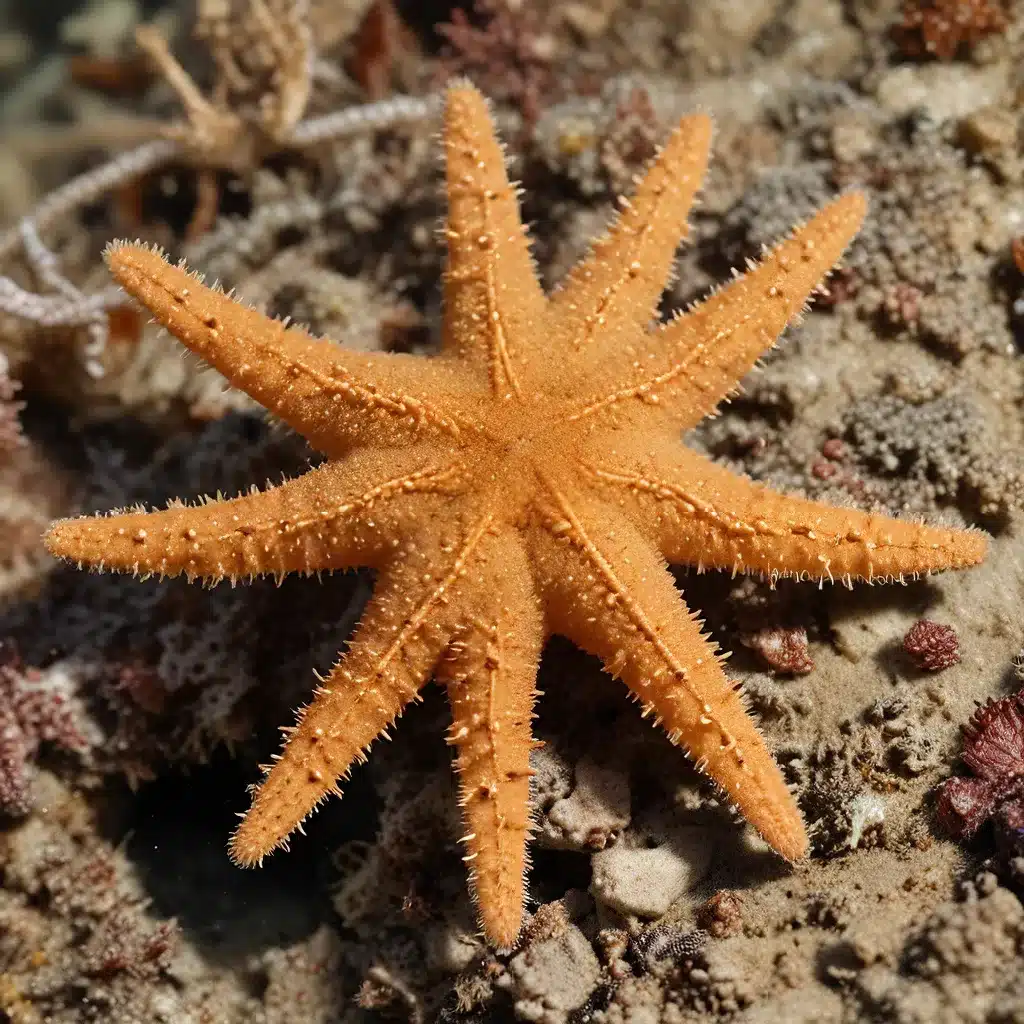
Unlocking the Secrets of Basket Stars
Basket stars, members of the Ophiuroidea class, are among the most mesmerizing and intricate marine invertebrates gracing our waters. These echinoderms, closely related to sea stars and sea urchins, have captivated the hearts and minds of aquarists and naturalists alike. Their intricate, branching arms and unique feeding behaviors make them true ambassadors of the underwater realm.
Gorgonocephalus eucnemis, the scientific name for the common basket star, is a species found across a wide range, from the Bering Sea to the Pacific coast of Mexico. These remarkable creatures can grow up to 80 centimeters in width when their arms are fully outstretched, creating a stunning display of nature’s architectural prowess. Their diverse coloration, ranging from beige to vibrant white, further adds to their visual appeal.
The feeding mechanisms of basket stars are equally captivating. As the current increases, these echinoderms unfurl their intricate arms, forming a basket-like structure to ensnare plankton and other suspended particles. Microscopic hooks and mucus help guide the captured prey towards the mouth, located on the underside of the central disc. This intricate feeding process is a true marvel of nature, showcasing the adaptations that allow basket stars to thrive in high-current environments.
Unraveling the Mysteries of Basket Star Reproduction
Basket star reproduction is a fascinating process that involves several unique and intricate stages. These echinoderms reproduce through broadcast spawning, where adult males and females release their gametes into the water. The embryos then develop inside the polyps of red soft coral, where they are thought to feed on the coral’s eggs.
Remarkably, when the juvenile basket stars emerge from the coral polyps, they appear to hang onto the outside of the coral until they reach around 5 centimeters in disk diameter. At this point, they shuffle off and begin crawling onto adult basket stars, where they can steal food bundles from the parent’s mouths. This remarkable life cycle, involving multiple stages and host species, highlights the complex and interconnected nature of the marine ecosystem.
Breathing and Adaptations of Basket Stars
Basket stars have a unique respiratory system that has been the subject of fascinating research. Studies have shown that these echinoderms exhibit changes in their breathing rate when exposed to different environmental conditions, such as the introduction of food or reduced oxygen levels.
Researchers have found that when basket stars detect the presence of food, such as a slurry of krill, their breathing rate can increase from around 10 to 30 breaths per hour up to 30 to 45 breaths per hour. This rapid increase in ventilation suggests that basket stars have adapted to efficiently capture and process their prey, ensuring they can maximize the energy and nutrients they obtain from their feeding activities.
Interestingly, basket stars have also been observed to increase their breathing rate when exposed to reduced oxygen levels. This adaptation allows them to maintain their respiratory function and continue thriving in their deep-water habitats, where oxygen availability can be more limited.
Basket Stars: Indicators of Ocean Health
Basket stars, like many other marine invertebrates, can serve as valuable indicators of the overall health of the ocean ecosystem. Their distribution and abundance can provide insights into the environmental conditions and stressors present in their habitats.
King Aquarium emphasizes the importance of understanding the role of basket stars and other echinoderms in maintaining the delicate balance of marine ecosystems. As sensitive organisms, changes in their populations or behavior can signal broader environmental issues, such as pollution, climate change, or disease outbreaks.
By closely monitoring basket star populations and their responses to various stressors, aquarists and marine biologists can gain valuable information about the overall state of the ocean. This knowledge can then be used to inform conservation efforts, habitat restoration, and sustainable management practices, ensuring the long-term health and resilience of these fascinating creatures and the ecosystems they call home.
Cultivating Basket Stars in the Aquarium
Keeping basket stars in the aquarium setting is a challenging but rewarding endeavor for dedicated hobbyists. These delicate echinoderms require specialized care and a meticulously maintained environment to thrive.
One of the key considerations for successfully keeping basket stars is the water flow. These organisms depend on strong, consistent currents to capture their food and maintain their respiratory functions. Aquarists must ensure their tank setup includes powerful circulation pumps and carefully designed water movement patterns to mimic the natural conditions these stars are adapted to.
Lighting is another critical factor, as basket stars are sensitive to changes in light intensity and spectrum. Providing the appropriate LED or T5 fluorescent lighting that replicates the deep-water environment can help ensure the basket stars’ well-being and encourage natural behaviors, such as arm extension and feeding.
Maintaining optimal water parameters, such as temperature, pH, and dissolved oxygen levels, is also essential for the long-term health of basket stars. Regular water testing and targeted adjustments can help aquarists create the ideal conditions for these captivating creatures.
Conclusion: Appreciating the Diversity of Echinoderms
Basket stars are just one example of the remarkable diversity and adaptations found among echinoderms, a phylum that includes sea stars, sea urchins, sea cucumbers, and more. By understanding the unique behaviors, life cycles, and ecological roles of these marine invertebrates, aquarists and enthusiasts can develop a deeper appreciation for the intricate web of life that exists beneath the ocean’s surface.
Cultivating a thriving echinoderm ecosystem in the aquarium setting requires a combination of specialized knowledge, dedicated care, and a reverence for the natural world. By embracing the challenges and nuances of keeping these captivating creatures, aquarists can not only enjoy the beauty of basket stars but also contribute to the broader understanding and conservation of these vital components of marine ecosystems.

